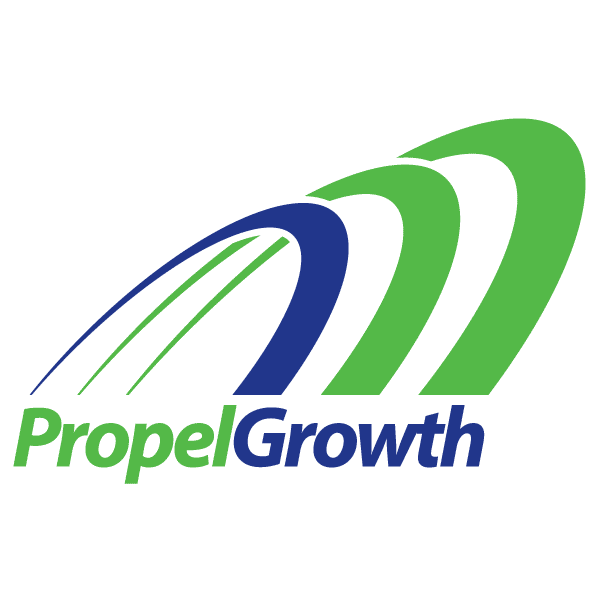
A few years ago, I wrote an article on how to use the Blue Ocean concept of a Strategy Canvas to develop a competitive strategy. That page continues to be one of the most popular pages on the PropelGrowth website for search traffic.
The focus of Blue Ocean Strategy is creating “new market space that is uncontested.” It’s particularly useful for firms experiencing a lot of competition in their core business. Its purpose is to find market niches where the competition is irrelevant. This allows firms to reconstruct market boundaries and create and capture new demand that the competition isn’t targeting. This also helps avoid price wars and shrinking profits.
The Blue Ocean approach is even more important today for B2B financial technology firms competing with an aging product set and well-established market. Most fin-tech firms sell commoditized offerings to an industry with limited growth potential. In order to expand, these firms need to identify new, untapped markets where they can differentiate themselves. This means either diversifying outside your core customer base or bringing new capabilities to the existing base.
This isn’t just about differentiating your existing product set or adding a few features to make it more competitive. This is about finding a new, untapped market niche and providing solutions customized to that niche.
BlockChain is an Example of a Blue Ocean Strategy
Blockchain and distributed ledger providers are trying to do this. They’ve developed a new product category that can help fill an unmet need in the financial industry. Now a number of startups are chasing this category, each racing to become the dominant player. If they’re not careful, they risk ending up like the CEP industry in 2009.
How the CEP Industry Got It Wrong
This reminds me of the Complex Event Processing (CEP) field in the mid-2000’s. At the time, I was the co-founder of one of those startups – a company called Kaskad Technology. CEP was a new approach for processing massive amounts of data, identifying events based on related data points, and acting on those complex events in real-time. In 2005, there were around 5 or 6 core vendors targeting the financial services space. Most of us were chasing a small handful of deals, primarily in what was then a relatively new trend in proprietary trading.
I remember meeting with a team at Citigroup and learning that they had met with and requested proposals from all 6 vendors. We were all chasing this one deal, and fiercely competing for the same project. While the technical approach for the engines varied widely from firm to firm, we all ended up competing on price.
There were actually plenty of blue ocean opportunities in surveillance, risk management, fraud detection, market data, and other use cases that these firms were ignoring. Instead, they ended up pushing down the pricing ceiling for what was at the time still immature technology.
Creating pricing pressure too early in the market’s development made it difficult for the firms to generate enough profits from deals to reinvest in R&D. Eventually, they figured out that they needed to chase different markets, but only after a very expensive 24 months fighting for the same few deals and permanently lowering the price ceiling for the technology.
The pricing pressure also permanently lowered the potential growth for these firms. Eventually all of them were sold off…before CEP really took off. Now, nearly every financial services platform – both home-grown and vendor-built – contain aspects of CEP. But the vendors who created this market are all gone. They were either sold or went under and didn’t really get to participate in the massive market adoption.
When you’re faced with a highly competitive landscape, it’s critical to find new markets and creative ways to differentiate in order to remain profitable. To do this, you have to re-orient. One way to find new markets is to focus on non-customers – companies/people who are not currently using your OR your competitors’ services, but who could benefit if they thought about their needs differently.
Note: I recently interviewed John Bates, the founder and CEO of Apama, which was sold to Progress Software in 2005 and then restructured to become a part of Software AG in 2013. John talks about how he approached the business and competitive strategy for this CEP provider, and how he sold it not once, but twice, creating significant growth opportunities for both acquiring companies. Click to access the podcast of our interview.
The Purpose of a Strategy Canvas
The purpose of a strategy canvas is to help identify blue ocean opportunities that you can dominate — untapped markets your competition is ignoring.
A strategy canvas is very different than the typical SWOT analysis. It requires a deep understanding of the market and a realistic assessment of your product and your competition. (Note: A client’s internal team could also represent competition).
You can find more information about how to build a strategy canvas and an example from the CEP space in my original strategy canvas article.
Market Research Needed for a Strategy Canvas
To build an effective strategy canvas, you’ll need to do some serious market research. This includes a detailed competitive analysis, buyer research, and non-customer research.
Start by defining the core factors on which your industry competes. Assess your existing target market to understand why they buy the products/services. For this research, interview both your clients and customers of your competitors.
I find that lost deals, particularly those deals you lost to “no decision” provide invaluable insight. The more you can learn about why those prospects didn’t buy, the closer you’ll come to figuring out the needs of an uncontested market. Don’t just focus on deals you lost late in the cycle. Interview people who said “no” early. You can find a wealth of information from these people about potential un-met needs and new markets.
Marketing Strategy for a Blue Ocean
Your blue ocean will require a different marketing approach than the rest of your market. Here, you’ll need to create demand by educating customers about their needs, and convincing them to consider new approaches. This will demand an integrated thought leadership and public relations strategy to get your message out and build market awareness.
Quality thought leadership content helps position companies as experts in their space, particularly when they remain committed to addressing topics at the forefront of their target audience’s minds. For more information on thought leadership programs, here are a few articles:
- Facilitating The Buying Cycle With Content Marketing
- Content and Thought Leadership To Support The Buying Cycle
- Are You a Thought Leader or a Thought Follower?
How We Help
PropelGrowth can help you with the research needed to create a strategy canvas and help you identify blue ocean opportunities. Some of the types of research we routinely do for clients include:
- Customer perception of your firm’s capabilities: How do they currently use your technology? What business problems does your technology solve? How does the use of your capabilities break down by user type? What are the key values they obtain? Where does the technology fall short? What are they still doing manually? What workarounds have they built to address shortcomings?
- Competitive analysis: What part of the market do you share with the competition? What areas are underserved by the competition? What areas are well-served by the competition? What areas are already commoditized and which represent opportunities for commoditization?
- Untapped innovation:Are your customers using or considering using capabilities in a way you’ve yet to consider? How can you expand your technology based on that information? Where can you add features and capabilities that will increase usage?
- Peripheral market opportunities: Where can you expand your business to create new opportunities in new and existing markets?
Subscribe to Learn More
Every week, we publish new insights and ideas for your marketing strategy. Subscribe to our blog so you don’t miss these helpful tips.
![]()
- 4 Steps to Optimize Your LinkedIn Profile for Sales Prospecting – February 12, 2021
- The Reality of Cold Calling for B2B Sales – January 11, 2021
- Can Inbound Marketing Generate Enough Leads? – January 9, 2021






